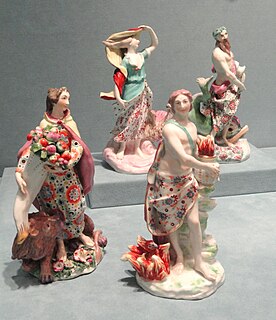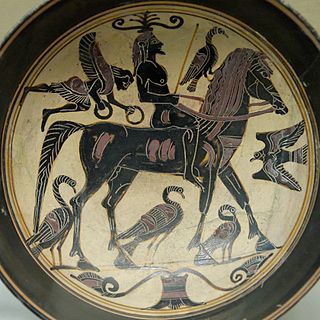Related Research Articles

Anaximenes of Miletus was an Ancient Greek, Ionian Pre-Socratic philosopher from Miletus in Asia Minor, active in the latter half of the 6th century BC. The details of his life are obscure because none of his work has been preserved. Anaximenes' ideas are only known today because of comments about him made by later writers, such as Aristotle.

Classical elements typically refer to earth, water, air, fire, and (later) aether which were proposed to explain the nature and complexity of all matter in terms of simpler substances. Ancient cultures in Greece, Tibet, and India had similar lists which sometimes referred, in local languages, to "air" as "wind" and the fifth element as "void".
Fire is one of the four classical elements along with Earth, Water and Air in ancient Greek philosophy and science. Fire is considered to be both hot and dry and, according to Plato, is associated with the tetrahedron.
Air is one of the four classical elements along with Water, Earth and Fire in ancient Greek philosophy and in Western alchemy.
Water is one of the classical elements in ancient Greek philosophy along with Air, Earth and Fire, in the Asian Indian system Panchamahabhuta, and in the Chinese cosmological and physiological system Wu Xing. In contemporary esoteric traditions, it is commonly associated with the qualities of emotion and intuition.
Earth is one of the classical elements, in some systems being one of the four along with Air, Fire, and Water.

Plato was a Greek philosopher born in Athens during the Classical period in Ancient Greece. He founded the Platonist school of thought and the Academy, the first institution of higher learning on the European continent.

Augury is the practice from ancient Roman religion of interpreting omens from the observed behavior of birds. When the individual, known as the augur, interpreted these signs, it is referred to as "taking the auspices". 'Auspices' is from the Latin auspicium and auspex, literally "one who looks at birds." Depending upon the birds, the auspices from the gods could be favorable or unfavorable. Sometimes politically motivated augurs would fabricate unfavorable auspices in order to delay certain state functions, such as elections. Pliny the Elder attributes the invention of auspicy to Tiresias the seer of Thebes, the generic model of a seer in the Greco-Roman literary culture.
Syrianus was a Greek Neoplatonist philosopher, and head of Plato's Academy in Athens, succeeding his teacher Plutarch of Athens in 431/432. He is important as the teacher of Proclus, and, like Plutarch and Proclus, as a commentator on Plato and Aristotle. His best-known extant work is a commentary on the Metaphysics of Aristotle. He is said to have written also on the De Caelo and the De Interpretatione of Aristotle and on Plato's Timaeus.

Meteorology is a treatise by Aristotle. The text discusses what Aristotle believed to have been all the affections common to air and water, and the kinds and parts of the earth and the affections of its parts. It includes early accounts of water evaporation, earthquakes, and other weather phenomena.
According to ancient and medieval science, aether, also known as the fifth element or quintessence, is the material that fills the region of the universe beyond the terrestrial sphere. The concept of aether was used in several theories to explain several natural phenomena, such as the traveling of light and gravity. In the late 19th century, physicists postulated that aether permeated all throughout space, providing a medium through which light could travel in a vacuum, but evidence for the presence of such a medium was not found in the Michelson–Morley experiment, and this result has been interpreted as meaning that no such luminiferous aether exists.

Complexion in humans is the natural color, texture, and appearance of the skin, especially on the face.
The Ionian school of Pre-Socratic philosophy was centred in Miletus, Ionia in the 6th century BC. Miletus and its environment was a thriving mercantile melting pot of current ideas of the time. The Ionian School included such thinkers as Thales, Anaximander, Anaximenes, Heraclitus, Anaxagoras, and Archelaus. The collective affinity of this group was first acknowledged by Aristotle who called them physiologoi (φυσιολόγοι), meaning 'those who discoursed on nature'. The classification can be traced to the second-century historian of philosophy Sotion. They are sometimes referred to as cosmologists, since they were largely physicalists who tried to explain the nature of matter.

Archelaus was an Ancient Greek philosopher, a pupil of Anaxagoras, and may have been a teacher of Socrates. He asserted that the principle of motion was the separation of hot from cold, from which he endeavoured to explain the formation of the Earth and the creation of animals and humans.
Antepredicaments, in logic, are certain previous matters requisite to a more easy and clear apprehension of the doctrine of predicaments or categories. Such are definitions of common terms, as equivocals, univocals, etc., with divisions of things, their differences, etc. They are thus called because Aristotle treated them before the predicaments, hoping that the thread of discourse might not afterwards be interrupted.

Calcidius was a 4th-century philosopher who translated the first part of Plato's Timaeus from Greek into Latin around the year 321 and provided with it an extensive commentary. This was likely done for Bishop Hosius of Córdoba. Very little is otherwise known of him.

Vital heat, also called innate or natural heat, or calidum innatum, is a term in Ancient Greek medicine and philosophy that has generally referred to the heat produced within the body, usually the heat produced by the heart and the circulatory system. Vital heat was a somewhat controversial subject because it was formerly believed that heat was acquired by an outside source such as the element of fire.
Atomism is a natural philosophy proposing that the physical universe is composed of fundamental indivisible components known as atoms.
Philosophy of matter is the branch of philosophy concerned with issues surrounding the ontology, epistemology and character of matter and the material world. The word matter is derived from the Latin word materia, meaning "wood", or “timber”, in the sense "material", as distinct from "mind" or "form". The image of wood came to Latin as a calque from the ancient Greek philosophical usage of hyle (ὕλη).
The theory of Forms or theory of Ideas is a philosophical theory, concept, or world-view, attributed to Plato, that the physical world is not as real or true as timeless, absolute, unchangeable ideas. According to this theory, ideas in this sense, often capitalized and translated as "Ideas" or "Forms", are the non-physical essences of all things, of which objects and matter in the physical world are merely imitations. Plato speaks of these entities only through the characters of his dialogues who sometimes suggests that these Forms are the only objects of study that can provide knowledge. The theory itself is contested from within Plato's dialogues, and it is a general point of controversy in philosophy. Nonetheless, the theory is considered to be a classical solution to the problem of universals.
References
- ↑ Jan Opsomer, "Antiperistasis: A Platonic Theory," in: Jiménez, López, Aguilar (eds.), Plutarco, Platón y Aristóteles. Actas del V Congreso Internacional de la I.P.S. (1999), p. 417-430
- ↑ See Timaeus 77a-81e.
- ↑ The etymology points to Ancient Greek, ἀντιπερίστασις, formed of ἀντί ("against") and περίστασις ("standing around")
- ↑ Golitsis P, Simplicius and Philoponus on the Authority of Aristotle, Brill’s Companion to the Reception of Aristotle in Antiquity, (ed.) A. Falcon, Leiden, Boston: Brill, 2016
 This article incorporates text from a publication now in the public domain : Chambers, Ephraim, ed. (1728). "Antiperistasis". Cyclopædia, or an Universal Dictionary of Arts and Sciences (1st ed.). James and John Knapton, et al.
This article incorporates text from a publication now in the public domain : Chambers, Ephraim, ed. (1728). "Antiperistasis". Cyclopædia, or an Universal Dictionary of Arts and Sciences (1st ed.). James and John Knapton, et al.- "Antiperistasis", Cyclopædia, Ephraim Chambers, 1728
